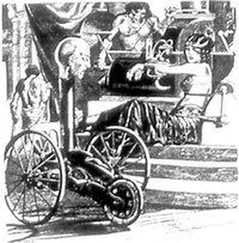Edmund Flagg - Flagg's The Far West, 1836-1837, part 1
Здесь есть возможность читать онлайн «Edmund Flagg - Flagg's The Far West, 1836-1837, part 1» — ознакомительный отрывок электронной книги совершенно бесплатно, а после прочтения отрывка купить полную версию. В некоторых случаях можно слушать аудио, скачать через торрент в формате fb2 и присутствует краткое содержание. Издательство: Иностранный паблик, Жанр: foreign_antique, foreign_prose, Путешествия и география, на английском языке. Описание произведения, (предисловие) а так же отзывы посетителей доступны на портале библиотеки ЛибКат.
- Название:Flagg's The Far West, 1836-1837, part 1
- Автор:
- Издательство:Иностранный паблик
- Жанр:
- Год:неизвестен
- ISBN:нет данных
- Рейтинг книги:4 / 5. Голосов: 1
-
Избранное:Добавить в избранное
- Отзывы:
-
Ваша оценка:
- 80
- 1
- 2
- 3
- 4
- 5
Flagg's The Far West, 1836-1837, part 1: краткое содержание, описание и аннотация
Предлагаем к чтению аннотацию, описание, краткое содержание или предисловие (зависит от того, что написал сам автор книги «Flagg's The Far West, 1836-1837, part 1»). Если вы не нашли необходимую информацию о книге — напишите в комментариях, мы постараемся отыскать её.
Flagg's The Far West, 1836-1837, part 1 — читать онлайн ознакомительный отрывок
Ниже представлен текст книги, разбитый по страницам. Система сохранения места последней прочитанной страницы, позволяет с удобством читать онлайн бесплатно книгу «Flagg's The Far West, 1836-1837, part 1», без необходимости каждый раз заново искать на чём Вы остановились. Поставьте закладку, и сможете в любой момент перейти на страницу, на которой закончили чтение.
Интервал:
Закладка:
51
The English Island of 1836 is probably the Power's Island of today. It is three miles long, and forms a part of Scott County, Missouri, more than twenty miles above Cairo. – Ed.
52
Herbert. – Flagg.
53
For a sketch of Cape Girardeau, see A. Michaux's Travels , in our volume iii, p. 80, note 154. – Ed.
54
A superior quality of kaolin, or china clay, is mined in large quantities in Cape Girardeau County. Marble ninety-nine per cent pure, is procured in abundance. – Ed.
55
"Muddy River," usually called "Big Muddy," is the English translation of the French Rivière au Vase , or Vaseux . Formed by the union of two branches rising in Jefferson County, Illinois, it flows in a southwesterly direction and empties into the Mississippi about twenty-five miles above Cape Girardeau. It is one hundred and forty miles long. – Ed.
56
Fountain Bluff is six miles above the mouth of the Big Muddy. Flagg's descriptions are in the main accurate. – Ed.
57
Grand Tower, seventy-five feet high, and frequently mentioned by early writers, is a mile above the island of the same name, at the mouth of the Big Muddy, and stands out some distance from the Missouri side. Grand Tower Island was an object of much dread to boatmen during the days of early navigation on the Mississippi. A powerful current sweeping around Devil's Oven, frequently seized frail or unwieldy craft to dash it against this rock. Usually the boatmen landed, and by means of long ropes towed their vessels along the Illinois side, past this perilous rock. – Ed.
58
The Mississippi between the mouth of the Kaskaskia River and Cape Girardeau offered many obstructions to early navigation. As at Grand Tower, the boatmen frequently found it necessary to land and tow their boats past the dangerous points, and here the Indians would lie in ambush to fall upon the unfortunate whites. The peril of these places doubtless lent color to their nomenclature. Flagg's descriptions are fairly accurate except in the matter of dimensions, wherein he tends to exaggeration. – Ed.
59
$105,000. – Flagg.
60
For Red River raft, see James's Long's Expedition , in our volume xvii, p. 70, note 64. – Ed.
61
In reference to the American Bottom, see Ogden's Letters , in our volume xix, p. 62, note 48. – Ed.
62
For an account of Ste. Genevieve, see Cuming's Tour , in our volume iv, p. 266, note 174.
According to Austin, cited below, La Motte (or La Mothe) Cadillac, governor of Louisiana, went on an expedition (1715) to the Illinois in search of silver, and found lead ore in a mine which had been shown him fifteen miles west of the Mississippi. It is believed by some authorities that this was the famous "Mine la Mothe," at the head of the St. Francis River. Schoolcraft, however, says that Philip Francis Renault, having received mining grants from the French government, left France in 1719, ascended the Mississippi, established himself the following year near Kaskaskia, and sent out small companies in search of precious metals; and that La Mothe, who had charge of one of these companies, soon discovered the mine that still bears his name. It was operated only at intervals, until after the American occupation, when its resources were developed. Under the Spanish domination (1762-1800), little was done to develop the mine. In 1763, however, Francis Burton discovered the "Mine à Burton," on a branch of Mineral Fork. Like the "Mine la Mothe," it was known to the Indians before the discovery by the whites, and both are still operated. Burton was said to have been alive in 1818, at the age of a hundred and six; see Colonel Thomas Benton's account of him in St. Louis Enquirer , October 16, 1818.
For an account of primitive mining operations, see Thwaites, Wisconsin Historical Collections , xiii, pp. 271-292; Moses Austin, "Lead Mines of Ste. Geneviève and St. Louis Counties," American State Papers ( Public Lands ), iii, pp. 609-613; and H. R. Schoolcraft, Lead Mines of Missouri (New York, 1819). – Ed.
63
From 1738 to 1744, the mines were considered as public property: but in the year last mentioned François Vallé received from the French government a grant of two thousand arpents of land (1,666 acres) including "Mine la Mothe," and eighteen years later twenty-eight thousand arpents (23,333 acres) additional. At Vallé's death the land passed to his sons, François and John, and Joseph Pratt, a transfer confirmed by Congress in 1827. The next year it was sold to C. C. Vallé, L. E. Linn, and Everett Pratt. In 1830 it was sold in part and the remainder leased. In 1868 the estate passed from the hands of the Vallés. – Ed.
64
Pilot Knob is a conical-shaped hill, a mile in diameter, in Iron County, Missouri, seventy-five miles southwest of St. Louis, and is rich in iron ore. In the War of Secession it was the scene of a battle between General Sterling Price and General Hugh B. Ewing (September 26, 27, 1864).
Iron Mountain is an isolated knob of the St. François Mountains in St. François County, eighty miles south of St. Louis. One of the richest and purest iron mines in the United States is found there. – Ed.
65
The Peoria were one of the five principal tribes of the Illinois Confederation. They resided around the lake in the central portion of Illinois, which bears their name. In 1832 they were removed to Kansas, and in 1854 to Indian Territory, where, united with other tribes, they still reside. – Ed.
66
For a short account of Fort Chartres, see A. Michaux's Travels , in our volume iii, p. 71, note 136. – Ed.
67
For Prairie du Rocher see A. Michaux's Travels , in our volume iii, p. 70, note 133. The legend referred to is, "Michel de Couce" by James Hall, in his Legends of the West .
Contrary to Flagg's statement that there exists no description of Fort Chartres worthy of its history, Philip Pittman, who visited the place in 1766, gives a good detailed description of the fort in his Present State of the European Settlements on the Missisippi (London, 1770), pp. 45, 46. – Ed.
68
For location and date of settlement of Herculaneum, see Maximilian's Travels , in our volume xxii, p. 212, note 122.
On a perpendicular bluff, more than a hundred feet in height, in the vicinity of Herculaneum, J. Macklot erected (1809) what was probably the first shot-tower this side of the Atlantic. The next year one Austin built another tower at the same point. According to H. R. Schoolcraft in his View of the Lead Mines of Missouri (New York, 1819), pp. 138, 139, there were in 1817 three shot-towers near Herculaneum, producing in the eighteen months ending June 1 of that year, 668,350 pounds of shot. From the top of small wooden towers erected on the edge of the bluff, the melted lead was poured through holes in copper pans or sieves. – Ed.
69
For the location of the Platine (usually spelled Plattin), see Maximilian's Travels , in our volume xxii, p. 212, note 123. Lead mining has been carried on in this district, intermittently, since 1824. – Ed.
70
See Maximilian's Travels , in our volume xxii, p. 212, note 123. – Ed.
Читать дальшеИнтервал:
Закладка:
Похожие книги на «Flagg's The Far West, 1836-1837, part 1»
Представляем Вашему вниманию похожие книги на «Flagg's The Far West, 1836-1837, part 1» списком для выбора. Мы отобрали схожую по названию и смыслу литературу в надежде предоставить читателям больше вариантов отыскать новые, интересные, ещё непрочитанные произведения.
Обсуждение, отзывы о книге «Flagg's The Far West, 1836-1837, part 1» и просто собственные мнения читателей. Оставьте ваши комментарии, напишите, что Вы думаете о произведении, его смысле или главных героях. Укажите что конкретно понравилось, а что нет, и почему Вы так считаете.












